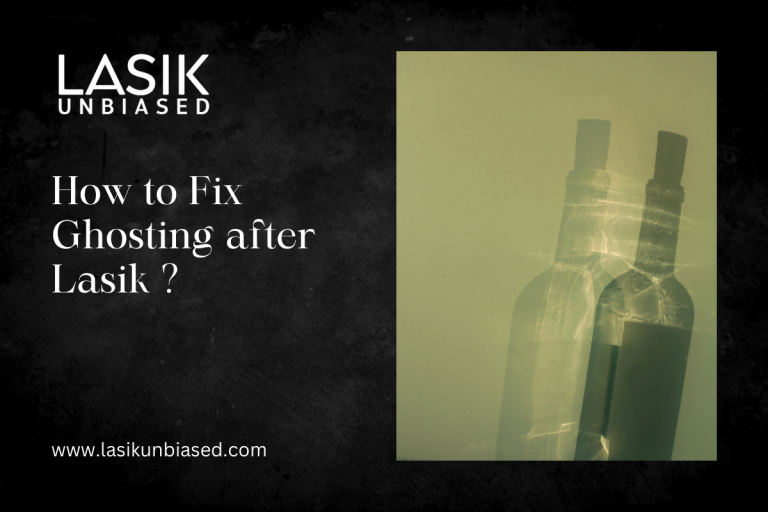Ghosting, or double vision, is a common concern that some people experience after undergoing LASIK (Laser-Assisted in Situ Keratomileusis) surgery. This condition is often described as seeing faint images or shadows alongside the primary image, leading to a blurry or distorted visual experience. Although ghosting can be unsettling, it is typically temporary and improves as the eyes heal after LASIK surgery. In some cases, however, it may persist and require further intervention.
This article explores how to address ghosting after LASIK, the potential causes, and the steps you can take to reduce or eliminate this issue.
What Is Ghosting After LASIK?
Ghosting is a visual phenomenon where a faint duplicate image appears alongside the main object you’re looking at. This can be caused by several factors, including changes in the cornea’s shape, refractive errors, or problems with the healing process following LASIK surgery.
In some cases, ghosting may occur when the corneal flap, created during LASIK, does not heal correctly. It may also result from dryness or other visual disturbances that can affect clarity. It is important to remember that ghosting is not always a sign of a serious complication; in most cases, it improves over time as your eyes recover.
Why Does Ghosting Occur After LASIK?
Understanding why ghosting occurs after LASIK can help ease concerns and provide insight into potential solutions.
1. Corneal Healing Process
After LASIK surgery, your cornea is in the process of healing. The laser reshapes the cornea to correct your vision, and during this time, the cornea may have slight irregularities that cause light to scatter. This scattering can lead to ghosting or double vision. As the cornea heals and stabilizes, the ghosting usually diminishes or disappears.
2. Dry Eyes
Dry eyes are a common side effect after LASIK surgery. The surgery can temporarily disrupt the tear production, leading to insufficient moisture on the eye’s surface. When your eyes are dry, it can affect the clarity of your vision and cause ghosting. Dryness may cause light to refract differently, leading to blurred or double vision.
3. Overcorrection or under-correction
In some cases, ghosting can result from slight overcorrection or under-correction of the refractive error during the LASIK procedure. This happens when the laser treatment does not fully address the prescription, leading to residual refractive errors that can cause ghosting. This issue is more familiar with high prescriptions.
4. Irregularities in the Corneal Flap
LASIK involves creating a thin flap in the cornea, which is then folded back to allow the laser to reshape the underlying tissue. If the flap is not positioned correctly or heals unevenly, it can cause visual disturbances, including ghosting.
5. Astigmatism
Astigmatism occurs when the cornea is irregular, causing light to focus unevenly. While LASIK aims to correct Astigmatism, residual astigmatism can remain after the procedure, leading to ghosting or blurred vision.
How to Fix Ghosting After LASIK?
Although ghosting after LASIK is often temporary and resolves on its own, there are steps you can take to address it and speed up the healing process.
1. Consult Your LASIK Surgeon
If you’re experiencing ghosting after LASIK, it is essential to consult with your surgeon. Your eye care professional will assess your condition, determine the underlying cause, and recommend the most appropriate action.
In some cases, ghosting may resolve independently within a few weeks or months as your eyes fully heal. However, if the ghosting persists, your surgeon may suggest additional treatments or adjustments to improve your vision.
2. Allow Time for Healing
One of the most important things to do after LASIK is to give your eyes time to heal. Ghosting may be a temporary side effect during the early stages of recovery. It is common for vision to fluctuate in the first few weeks as your eyes adjust to their new shape. Most patients experience significant improvement in their vision within 1 to 3 months. During this period, be patient and avoid stressing over temporary visual disturbances.
3. Use Lubricating Eye Drops
Dry eyes are a common cause of ghosting after LASIK. To alleviate dryness and improve the quality of your vision, you can use lubricating eye drops as your surgeon recommends. These drops help maintain moisture on the surface of your eyes and can reduce ghosting caused by dryness.
Use preservative-free artificial tears, as these are gentler on the eyes, especially during recovery. To reduce dryness, your doctor may also recommend other treatments, such as punctual plugs or prescription eye drops.
4. Consider a Follow-Up LASIK Enhancement
In some cases, ghosting may result from an undercorrection or overcorrection in your refractive error. If your LASIK surgery did not fully address your vision prescription, your surgeon may recommend a LASIK enhancement. This is a secondary procedure to fine-tune the results of the original surgery and can improve visual clarity.
An enhancement procedure is generally safe and can address residual refractive errors contributing to ghosting or other visual disturbances.
5. Address Astigmatism
If ghosting is related to residual Astigmatism, your surgeon may recommend further treatment to address this issue. In some cases, correcting Astigmatism may require additional LASIK treatment, such as an enhancement or the use of specialized lenses, such as toric contact lenses or glasses.
Astigmatism is often corrected during the LASIK procedure, but your doctor can work with you to find the best solution if it persists.
6. Consider Other Surgical Options
In rare cases, LASIK patients may experience persistent ghosting despite trying non-surgical treatments. Suppose the condition does not resolve with time or lifestyle adjustments. In that case, your surgeon may suggest other surgical options, such as PRK (Photorefractive Keratectomy) or ICL (Implantable Collamer Lens), depending on the severity and nature of the problem.
7. Follow Post-Operative Instructions Carefully
To optimize the healing process and reduce complications such as ghosting, it is essential to follow your surgeon’s post-operative instructions carefully. This includes using prescribed eye drops, avoiding rubbing your eyes and attending follow-up appointments. Proper aftercare will support healing and reduce the risk of vision disturbances.


